SEAT Ibiza 1.0 TSI SE
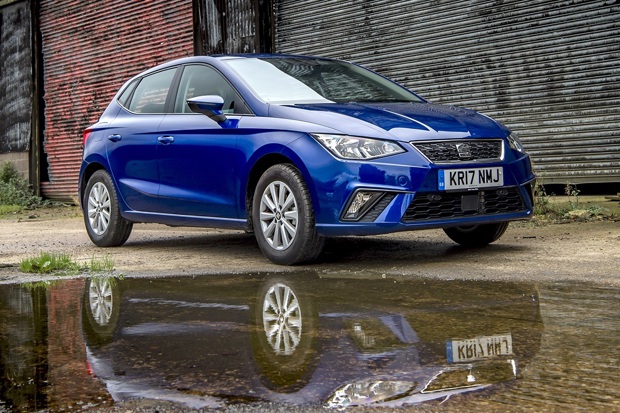
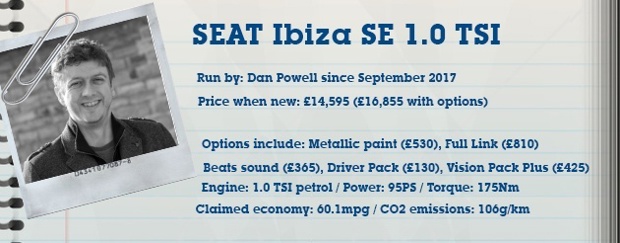
- We're going to Ibiza
- Air con cracks up in the heat
- Good things come in small packages with the Ibiza
- The space race in the Ibiza
- Feeling the chill
- Ibiza shows its class as a long hauler
- Winter in Ibiza
- Ibiza 1.0 TSI shows there is indeed life after diesel
- Platform 9 3/4
- SEAT Ibiza vs Ford Fiesta - which is better?
- One step to well-being – why the Ibiza helps you de-stress after a long day at work
- SEAT Ibiza end of term report
We're going to Ibiza
Dan prepares for six months of holiday jokes and puns, with the delivery of the new SEAT Ibiza.
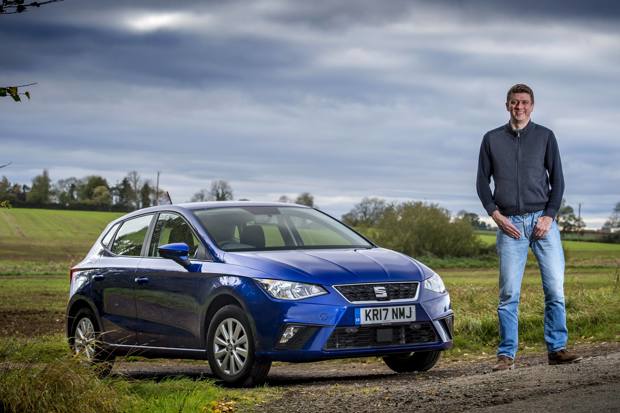
Date: 1 September 2017 | Current mileage: 100 | Claimed economy: 60.1mpg | Actual economy: 50.1mpg
If you’re in the market for a compact and affordable hatchback then the SEAT Ibiza will make a lot of sense. It's smart, stylish and available for under £200-per-month on PCP. It's also cheap to run for those who don't want diesel, with claimed economy for the petrols peaking at a pocket pleasing 67.3mpg.
What's more, being the all-new 2017 model, this version has been met with widespread praise with journalists hailing it as the greatest Ibiza ever. This was echoed by my colleague John Slavin who described it as one of the very best cars in its class. SEAT has made some bold claims too, with most of them aimed at closing the perceived gap between this and the market-leading, best-selling, all-conquering Ford Fiesta.
Given the praise, I've decided to use an Ibiza as my daily driver for the next six months to see what all the fuss is about. My test car is fitted with the 1.0-litre three-cylinder petrol and a five-speed manual gearbox. It's not the most efficient petrol in the range, but it does - on paper, at least - strike the right balance between performance and economy. Indeed, according to the official figures, the 1.0 TSI will provide 95PS, 175Nm of torque from 1500rpm and useful 60.1mpg.
When it comes to trim, I've tried to keep it realistic as possible for your typical small car buyer, by choosing the SE model. This includes most of the essentials, with air con, alloy wheels, front fog lights and electric door mirrors. However, I've added a few extras to cover all bases, with touchscreen navigation, cruise control, rear view camera and blue metallic paint.
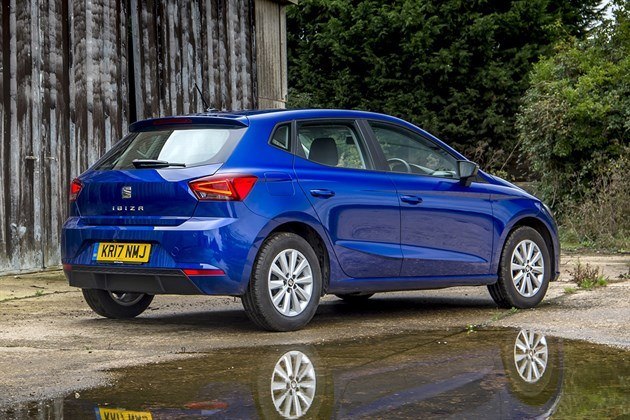
The SEAT Ibiza is smaller than the outgoing model, but promises more interior space
The 2017 Ibiza is a handsome car and the metallic 'Mystery Blue' - and no, I don't know what's mysterious about it - shows off its new lines rather well. Although from a distance it would be easy to confuse it with the larger Leon - but that's no bad thing
One of the big plus points in this new Ibiza is found in the back, with the 355-litre boot outstripping both the Fiesta (292) and much larger and more expensive Focus (316). Even the Skoda Fabia can't touch the SEAT (330) for space, which by my reckoning could make this one of the most practical small cars around.
When it comes to the engine, I have to admit that I'm a long-standing admirer of the 1.0 TSI petrol. Indeed, this isn't the first time I've sampled this three cylinder unit; back in 2016 I tested it in the Volkswagen Up and was left in no doubt about its quality when it comes to power and refinement. Hopefully this winning formula hasn’t been tampered with too much by its induction into the Ibiza.
Given that the Fiesta has been pushed to a high price point by Ford - starting around £13,000 - the gap between the two cars has been narrowed on paper. But it remains to be seen over the next six months if the Ibiza can genuinely prove that it has enough in its locker to nudge ahead of Britain’s favourite small car.
Air con cracks up in the heat
After just two weeks, the Ibiza is on its way back to SEAT HQ due to an air con fault.
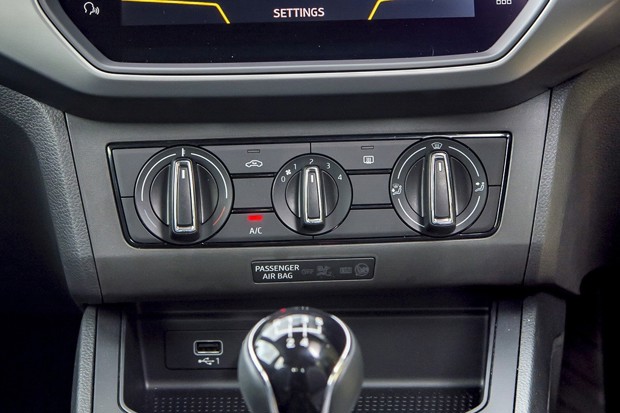
Date: 15 September 2017 | Current mileage: 798 | Claimed economy: 60.1mpg | Actual economy: 51.5mpg
It's been a bittersweet few weeks with the SEAT Ibiza. On the one hand, it’s impressed with its refined ride quality and zippy 1.0 TSI engine. On the other, it's disappointed with the air conditioning struggling in the heat. The air con issue started last week, with the windows misting up. Then, a few days later, I noticed that it took ages to cool the car down.
Air con problems aside, I've found my Ibiza experience to be very positive. The ride quality is excellent, with speed bumps and pot holes being ironed out with a soft and satisfying thump, while the turbocharged three-cylinder petrol engine has proven itself to be smooth and quiet. All-in-all, the Ibiza feels like a much more grown up car, compared to its predecessor.
The 1.0 TSI is fast becoming my new favourite automotive thing. I sampled it in the updated Volkswagen Up and was left in no doubt of its quality, but it really excels in the larger Ibiza package. It's still a bit early to draw any long-term conclusions about fuel economy - at 798 miles it's not yet run in - but the 95PS and 175Nm of torque feel a perfect match for the little SEAT.
Of course, if you want more punch, you can specify the 1.0 TSI with 115PS, but that version is only limited to FR models. As a result you'll have to spend at least £2000 extra compared to the 95PS version in SE trim. If truth be told, I'm not sure the Ibiza really needs more power. The 0-62mph dash can be completed in roughly 10 seconds and there is plenty of low gear pull for overtaking and joining the motorway.
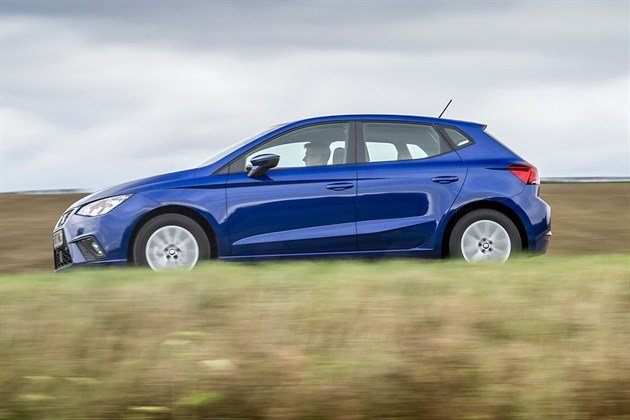
The Ibiza's 1.0 TSI petrol engine is one of the best in the small car business, accord to Dan
The woolly steering might disappoint enthusiastic drivers. It's not vague enough to be dangerous, far from it, but it doesn't have the firm feedback that you get in the Ford Fiesta. As a result it can be a little tricky to judge grip when carrying speed through a tight bend. However, again, few Ibiza drivers will be pushing the limitations of grip. And those that do will probably wait for the inevitable Cupra version. You also get slightly tighter steering in the FR version.
For what it lacks in dynamics, it more than makes up for in comfort. Indeed, with low levels of road and engine noise, the Ibiza is a wonderful little thing to take on long trips. The three-cylinder engine quietens to a low-pitched thrum on the motorway and the cushioned ride created a little oasis where you can really lean back and relax.
My long termer has a few extras and the Beats Sound System is one that provides some welcome entertainment on a long journey. Costing £365, it adds a 300W amplifier, six speakers and subwoofer, which provide crystal clear sound. In fact, it would be the perfect platform to show off a digital radio system - yet, for some reason, SEAT doesn't fit DAB as standard to the Ibiza.
Unfortunately, SEAT won't allow me to take it to local dealer to have the air con problem investigated, which means it has been taken back to SEAT HQ in Milton Keynes to get fixed. It should return in a few days and, hopefully, be firing on all cylinders when it comes to ventilation.
Good things come in small packages with the Ibiza
It might be smaller than its predecessor, but the Ibiza delivers big on refinement and space.
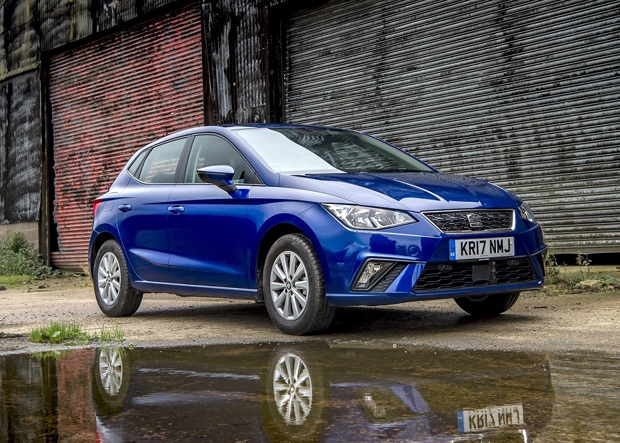
Date: 29 September 2017 | Current mileage: 1158 | Claimed economy: 60.1mpg | Actual economy: 52.6mpg
Typical small car has grown significantly in recent years. The MINI hatch, for example, now stands at two metres wide and four metres long, which contradicts its compact connotations. The reason for the bulging body panels is mostly down to buyer demands for more interior space and improved safety. But sadly, parking spaces haven’t kept up with the average size of cars. Especially in my hometown of Cambridge.
Thankfully, the SEAT Ibiza goes against the grain of ever-growing cars, because it's actually 6mm shorter than the car it replaces. Now, before anyone emails to complain, I accept this isn't a huge difference in size, but every little helps. Especially when it comes to parking and squeezing through small gaps in traffic.
As well as being a shave smaller than the old car, the Ibiza also has a longer wheelbase and this probably explains why the ride quality is so much better. Indeed, the suspension doesn't pitch or crash down heavily when confronted with pot holes and it also takes speed bumps in its stride.
The latest Ibiza also has a lot more interior space than previously, with the rear seats being large enough to carry two adults in comfort. There is an additional seat and headrest in the middle, but things turn into a bit of a squeeze when you try and fit three people in the back.

The Ibiza has enough room in the back for two adults to fit.
As you can gather, I'm quite impressed with the Ibiza, but it does have a black mark on its glowing report card in relation to the air con system. A few weeks ago it had to return to SEAT HQ for air con repairs. The system started playing up in the warm weather and - according to SEAT, a loose wire was the culprit.
However, since returning the car from the workshop, the air con still feels below par. In warm weather, for example, the cabin takes ages to cool down. I've also noticed that the windscreen mists up in wet weather, unless you have the blowers directed at the screen permanently and have the fan on a high setting.
Fuel economy is improving though, with the car now averaging at 52.6mpg over the 1158 miles that I've covered so far. With the engine stilling running-in, I'm optimistic that this figure will climb as the weeks and months tick by. It remains to be seen if the Ibiza will match the beat the three-cylinder petrol engine in the Baleno though.
With a busy few weeks coming up, I'll be clocking up quite a few miles in the SEAT and it will be interesting to see how it fares in terms of economy and refinement. What's more, with winter on the way, I'm curious how the heating system will cope with cold.
The space race in the Ibiza
When it comes to boot space, the SEAT Ibiza has the competition beaten with its gargantuan luggage capacity.
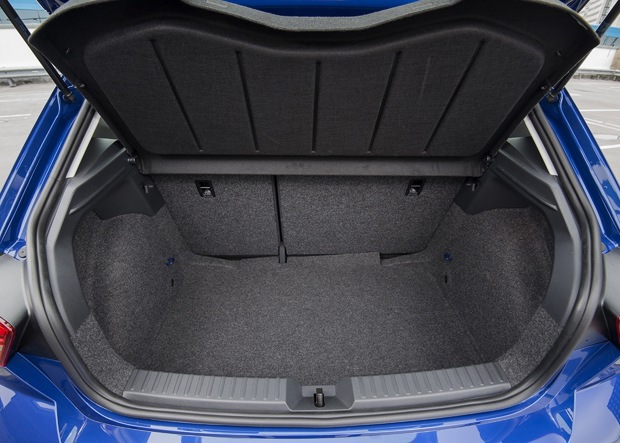
Date: 13 October 2017 | Current mileage: 1999 | Claimed economy: 60.1mpg | Actual economy: 53.7mpg
Small cars are traditionally all about compromises. Less space, less power and, sometimes, less respect from your fellow road users. Thankfully, on at least two of these points, the SEAT Ibiza laughs in the face of convention.
First off, the Ibiza is an attractive little thing. This is mostly because it borrows much of it styling from the larger Leon. Indeed, from the front, the two cars look almost identical, with the angular headlights and long bonnet giving the Ibiza the same family car feel as its larger stablemate.
The large interior and 355-litre boot gives the Ibiza the practically of a compact family car too. The deep and wide boot will easily hold a couple of large suitcases. You can also carry bulky things like a small wood chest of drawers by folding the 60/40 rear seats. It is surprisingly useful and the perfect companion for a trip to the local Ikea.
What's more, once you've emptied most of your bank account at the shops, the Ibiza's fuel economy will help you get home, with the 1.0 TSI petrol engine averaging close to the mid-50s. It's still short of the advertised 60.1mpg, but at 53.7mpg it extremely easy on the wallet when it comes to fuel.

The Ibiza's 1.0 TSI petrol engine is packed with torque and highly refined
As mentioned in previous updates, I'm a big fan of the Ibiza's turbocharged three-cylinder petrol engine. It is efficient, quiet and has enough pace to cover 0-62mph in a respectable amount of time. It also has plenty of torque, which means you don't always have to reach for a lower gear when traffic builds up in town.
Sometimes three-cylinder engines lack refinement, but the Volkswagen-built 1.0 TSI feels silky smooth, without any whistles or whines from the turbo. Something that can't be said of the impressive but noisy BoosterJet engine that you get in the Suzuki Baleno and Swift.
The Ibiza does disappoint when it comes to standard equipment though. There's no DAB audio, no electric door mirrors or cruise control on the mid-spec SE model - as tested here - and you also have to pay extra for parking sensors.
That said, the Ibiza is a lovely little thing to drive and the little refinement touches really do make all the difference, especially when it comes to road and engine noise. I also think it beats many of its rivals in the looks department, which means it does turn a few heads in the high street.
Feeling the chill
With the weather taking a turn for the worst, the Ibiza's heating system is giving Dan a lukewarm reception.
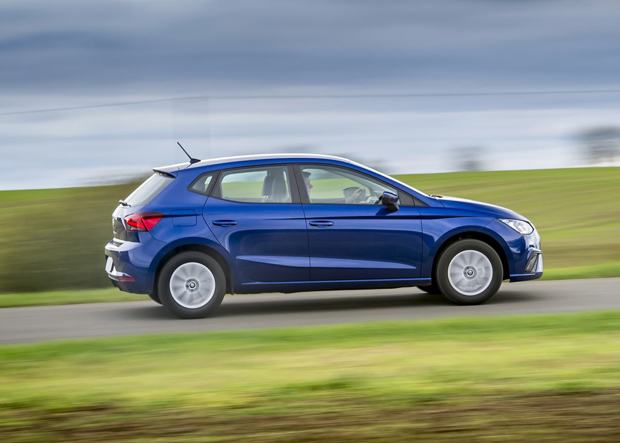
Date: 27 October 2017 | Current mileage: 2581 | Claimed economy: 60.1mpg | Actual economy: 53.6mpg
In a previous life, I use to get the train to work. This journey would involve a two mile cycle through the centre of Cambridge, which was great on a warm summer's evening, but pure hell in the winter. And on the coldest of days, it would take a good 10 minutes next to the train's radiator for me to get the feeling back in my fingers. It was really that cold.
These chilly days have come back to haunt me, because the heating system in the Ibiza isn't very good. On a typical morning, it takes 10 minutes for the heater to splutter out some lukewarm air, while the coldest of winter mornings will extend this wait to 15 minutes. That means I have to wait until I've driven out of Cambridge and trundled five miles down the A14 before I can start to warm up.
To be honest, I can't remember the last time I had a modern car that took this long to heat up. Even my first car, a rusty and unreliable 1984 Mk2 Fiesta wasn’t this bad. Fair enough, it didn't always start. Or stop. Or turn in the direction you wanted it to. And the radio had a mind of its own, but it always fired heat into the cabin within a couple of minutes of spluttering into life.
Another annoyance I’ve found is with the windscreen. Regardless of temperature, the windows have a tendency to mist up in wet weather, unless you have the fans on a high setting and permanently directed at the windscreen. This isn't so much an issue in the summer, but on a sub-zero winter's morning it is annoying because you can't direct the lukewarm air towards your hands or face.

The Ibiza's interior is colourful, but freezing cold in the winter due to the poor heater
Dodgy heater aside, the Ibiza hasn't missed a beat. Fuel economy appears to be stabilising in the mid-50s and the comfy seats and soft ride quality are brilliant for motorway runs. It's just a pity a third of my commute is in the cold.
Due to the variable nature of the A14, I've been using the touchscreen navigation to dodge traffic jams and find alternative routes to work. The bright and colourful screen is really easy to use and the voice commands are intelligent too. It isn't cheap though - navigation part of the Media System Plus package and costs £660 - or £810 if you include Full Link smartphone connectivity with Apple Car Play, Google Android Auto and Mirror Link.
Despite the cost, I'd probably spend extra on the navigation. It really does make life easier in traffic and the live traffic updates are a god send when the A14 has been closed due to an accident. What's more, I'm sure you could get the Media System Plus package for a much more affordable price if you negotiated hard with your local dealer. It's just a pity that DAB audio isn't included.
However, despite the grumbles, the quality of the Ibiza does shine through. This is mostly because it has the best turbocharged three-cylinder petrol engine of any car on the road. It's a fantastic engine and is head and shoulders above the competition in terms of performance and refinement. Which is something that cheers me up, when I'm freezing my fingers off and sitting in traffic in the mornings.
Ibiza shows its class as a long hauler
With a number of long distance drives under its belt, the Ibiza is proving to be a refined motorway machine

Date: 10 November 2017 | Current mileage: 3199 | Claimed economy: 60.1mpg | Actual economy: 53.7mpg
I have a theory that the A1 was the place where the Little Chef choose to lay down and die. I mean, the road is full of them, all boarded up, with faded red paintwork and shabby carparks filled with overgrown weeds. It gives the A1 something of a post-apocalyptic feel as you drive along and would be a fitting backdrop for any zombie movie.
However, while dull and dreary, this road is my only route to the north. Indeed, I had to head to the Lake District from our office near Peterborough recently to attend a car launch and the A1 was my only route out. It was also a good opportunity to put my daily driver through its paces, with the A1’s crappy, potholed roads and hills being a good test for the Ibiza’s suspension and 1.0-litre engine.
The 250-mile trip to Ullswater would traditionally route me up the A1, before turning onto the M62 and looping towards the M6 and then the Lake District. However, a series of accidents near Leeds meant the navigation – which automatically detects delays - redirected me straight up the A1 to Scotch Corner and then the A66.
Automatic route recalculating can be something of a curse with some navigation systems because they are so reliant on motion cameras. And sometimes the worst jams are on the roads that have none of these cameras, which means you often get redirected from the mouth of hell straight to Beelzebub's back door. However, with the SEAT's navigation, I manged to avoid all of this and headed northward-bound without any serious delays.
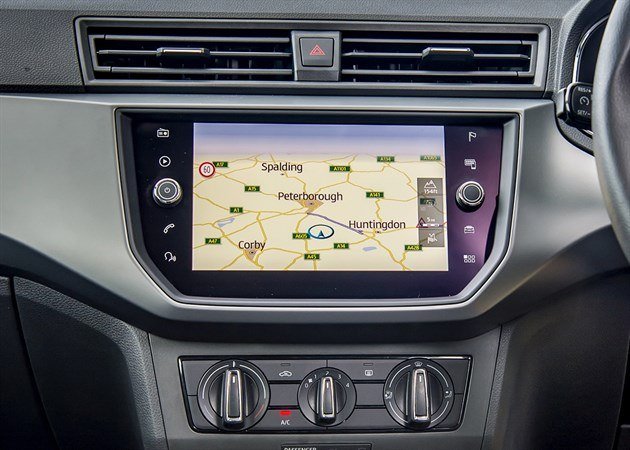
The touchscreen navigation is part of the Full Link package and costs a considerable £810
With the navigation showing me the way and the heating system kicking in after 20 minutes, the Ibiza proved itself to be a comfy long distance runner. The suspension does a really good job of absorbing all but the worst potholes, while engine and road noise levels are surprisingly low for such a small and relatively inexpensive car.
The grey cloth seats don't look particularly plush, but they're effective when it comes to keeping your back happy. The firm padding is extremely supportive and doesn't give any of the twinges or upper leg cramps that you can easily get after an hour or two behind the wheel of a small car.
The A66 is quite hilly and runs from Scotch Corner to Penrith, but the 1.0 TSI engine had little trouble coping with the moorland sections, which rise up to a height of 420 metres. Fuel economy was also respectable and in the mid-50s.
The only time the 1.0-litre petrol feels breathless is when overtaking on hills. With just 95PS, it's no speed demon and can get a little caught out when the horizon rises. But for the most part it works well enough, and is incredibly refined for such a small engine.
Winter in Ibiza
Lightweight and front-wheel drive: the Ibiza is the perfect cold weather companion.
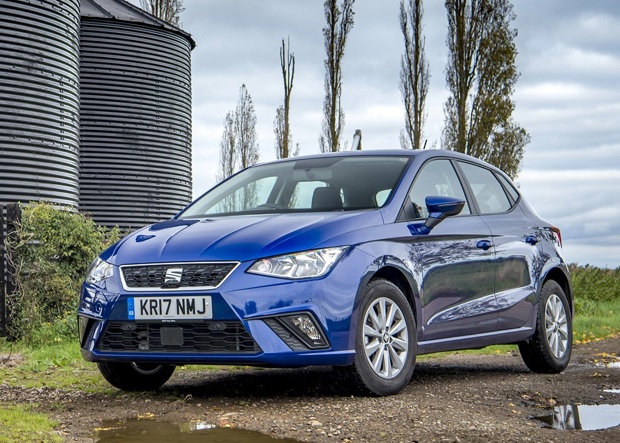
Date: 24 November 2017 | Current mileage: 3647 | Claimed economy: 60.1mpg | Actual economy: 53.6mpg
Winter in Ibiza. Three words that usually conjure images of sun kissed beaches, deep blue seas and fruity drinks, with tiny umbrellas in the top. Sadly, for me, a winter in Ibiza means East Anglia sub-zero temperatures and miles of roadworks.
The rebuild of the A14 sits slap bang in the middle of my daily commute from Cambridge to our office in Northamptonshire and, more often than not, results in lengthy delays. As a result, I usually have to divert and tackle the often untreated and icy B roads that run parallel along the A14 to get to work.
Owing to its front-wheel drive and low kerb weight - 1122kg, fact fans - the SEAT Ibiza is pretty good when it comes to wintery roads. Even on all-season tyres, the front-wheel drive set-up provides adequate grip, while slippery hills can be complete with ease if you're frugal on the throttle.
The overpowered steering can be an issue at times and this makes it tricky to fully understand where the front wheels are on the grip spectrum, but only the fast and furious will get caught out by the slightly vague steering system that the Ibiza employs.
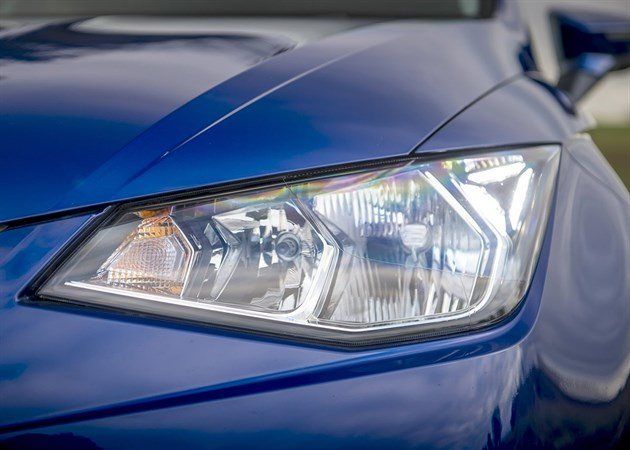
It might not get fancy LED headlights, but the halogens are more than up to the task
In an age of fancy LED and xenon headlights, the Ibiza’s halogens might seem a little quant by new-car standards, but they are fine for lighting the way through the dark mornings and evenings. They also won’t cost a grand or two to fix, should a bulb get dislodged or cracked by a pothole.
The Ibiza does get front fogs with a corning function, which light one side when turning from a junction or tackling a tight bend. According to the Ibiza's brochure, the corning function provides 'perfect visibility wherever you go' but if I'm honest I have barely noticed them working.
In fact, it wasn't until a friend asked if the fog lights were faulty that I realised they switched on when turning. It's a nice feature for other drivers, who might question an indication and turn you might make, but it provides very little improvement in visibility for the driver.
On the note of visibility, I’ve found that while attractive and pointy, the door mirrors are a little on the small side. This can make it a bit of a challenge when it comes to spotting cyclists in town or cars passing on the motorway. Although the blind spots are small and with a bit of neck bending you do get into the habit of covering them. But still, the mirrors do have a form over function feel to them.
Ibiza 1.0 TSI shows there is indeed life after diesel
Thinking of buying a diesel Ibiza? Don't. The 1.0 TSI is more than up to the task.

Date: 8 December 2017 | Current mileage: 4085 | Claimed economy: 60.1mpg | Actual economy: 54.1mpg
The petrol vs diesel debate is a hot one at Ask Honest John. Each week, we receive hundreds of questions from readers that focus on the all-important powertrain debate, with car buyers pondering whether petrol or diesel is best for them and their daily drive. Thankfully, when it comes to the SEAT Ibiza, the answer is an easy one. Buy petrol. And choose the 1.0 TSI.
The turbocharged three-cylinder engine is a real peach in the Ibiza and over the past few months it's proved to be efficient, regularly returning 54mpg. Factor in its refined and quiet running and its high levels of torque and it's difficult to argue for a diesel alternative.
You can get the Ibiza with diesel power, of course, in the form the 1.6 TDI. And while it's too early to understand the Real MPG picture of the 2017 Ibiza, it's clear that the 1.6 TDI didn't perform particularly well in the previous Ibiza, averaging close to 51mpg in real world driving – a figure that’s way short of its advertised 60+mpg.
With car buyers turning against diesel, only those covering gargantuan mileage - 20,000+ a year - would want to consider the Ibiza diesel. And even then, it's debateable if the 1.6 TDI would get anywhere near its advertised 74mpg.
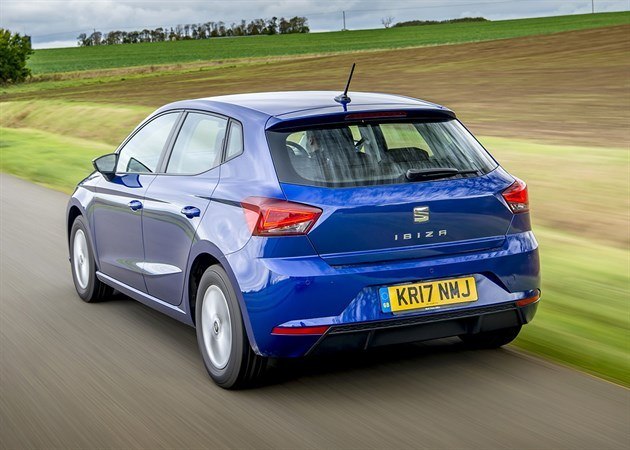
The brilliance of the 1.0 TSI petrol engine makes the diesel redundant for many Ibiza drivers
The three-cylinder petrol might not have as much low-gear pull as the four-cylinder diesel, but during the past few months I've seldom found it short of power. The turbocharged petrol has plenty of zip to cope with hills and a full load and only those looking to overtake slow moving traffic will ever need to reach for a lower gear.
Despite its compact dimensions, the Ibiza is surprisingly practical. The five-door layout means friends and family don't need to climb over the seats and leave muddy footprints to get in and out. The 355-litre boot is also one of the largest of any small hatchback, which means the Ibiza seldom has an issue when it comes to carrying large, bulky items.
And the downsides? Well, the spec levels are a little mean when it comes to standard equipment. My SE spec car, for example, has no DAB audio as standard, while the touchscreen navigation, cruise control and parking sensors are all pricy, optional extras.
And then there's the heating... which still takes an absolute age to get going. In fact, on the coldest mornings, I'm halfway to work before it starts to splutter anything that resembles heat. The issue is so bad that I've taken to wearing gloves, which produces a disapproving looks from half-frozen Cambridge cyclists who clearly have little sympathy for my plight.
Platform 9 3/4
Two cars almost become one when Dan compares the SEAT Ibiza with the Volkswagen Polo.

Date: 22 December 2017 | Current mileage: 4779 | Claimed economy: 60.1mpg | Actual economy: 54.2mpg
Given the huge resources needed to build new cars, it’s perhaps understandable that platform sharing is rife in the automotive industry. After all, why spend billions on several car platforms, when you can spawn dozens of new models from just the one?
As well as saving manufacturers colossal sums of money, platform sharing can also be a bit of a shrewd move for car buyers because it means you can get a premium motor at an affordable price. A case in point when you look at the SEAT Ibiza and Volkswagen Polo.
Indeed, just last week, I attended the launch of the Polo and was surprised to see how similar the two cars were. The excellent range of 1.0TSI petrol engines were under the bonnets, along with the same line-up of manual and automatic transmissions. The internal dimensions - and huge boot - were also all present and correct. So are they the same? Not quite.
While the Ibiza and Polo are undeniably similar, inside and out, they are not identical. The handling, for example, is slightly more refined in the Polo while better soundproofing and cabin materials give the Volkswagen a more rounded, more premium feel. For cost conscious car buyers, none of this will matter, but the Polo’s higher list price is clearly reflected in its fit and finish.
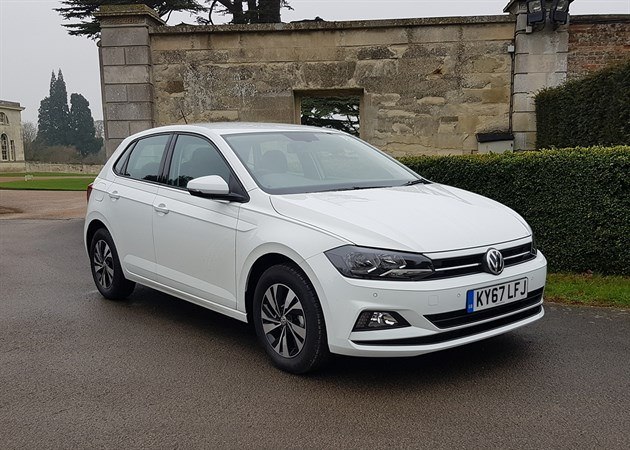
The Volkswagen Polo might share its mechanical underpinnings with the SEAT Ibiza, but its higher price point is reflected in its refinement and interior quality
The interior quality of the Polo – for me, at least – would be a potential dealer breaker. Yes, I know it's more expensive to buy compared to the Ibiza, but I'm a man who likes the nicer things in life and I’m a sucker for soft touch plastics and supple seats. The option of the coloured dashboard covers - which are unavailable for the Ibiza, as I write this – also inject some fun into the usual Volkswagen drab grey interior.
As you may be sensing, I'd be sorely tempted to spend more and choose the Polo over the Ibiza. But that's not to say there's anything fundamentally wrong with the SEAT. Far from it, as I approach the 5000 mile marker, it continues to impress. And apart from one or two niggles. it's proven to be a superb compact hatchback.
One area where the Ibiza continues to shine is in its 'big car' feel on the motorway. And by this I mean its composure and comfort at 70mph. Indeed, even on a windy, rainy winter's evening, the Ibiza feels sure footed and predictable, without any of the traditional small car wobbles or jitters that you usually get when the weather takes a turn for the worse.
The huge boot also means am never short on storage too. Big shopping trip? No problem, the 355-litre boot will swallow the weekly shop in one and still have some space to spare. That's not something that can be said of many compact hatchbacks on the market.
SEAT Ibiza vs Ford Fiesta - which is better?
SEAT Ibiza meets its key rival during a recent road test, but which compact hatchback is best?
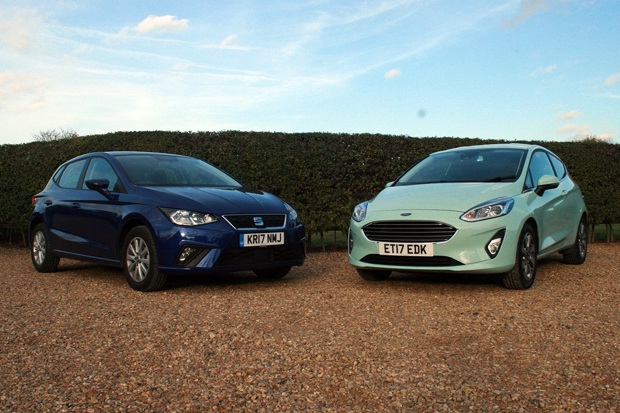
Date: 5 January 2018 | Current mileage: 5099 | Claimed economy: 60.1mpg | Actual economy: 54.3mpg
Like the SEAT Ibiza, the Ford Fiesta is an affordable, practical and stylish hatchback. It’s easy to drive too while mid-spec models get plenty of equipment as standard, which means you don't have to raid the expensive options list to get modest extras, like DAB audio, alloy wheels and LED daytime running lights.
Hardly surprising, perhaps, that the Fiesta has been Britain’s best-selling car for half a decade. In fact, you’d struggle to walk down a high street without seeing two or three of the things parked up or whizzing by. But how does the all-conquering Ford compare to the SEAT Ibiza?
It's difficult to deny that the latest Ibiza is a significant step up on its predecessor, with better engines, lower fuel costs and a higher quality interior. It's also one of the most practical hatchbacks you can buy. And even the larger Focus struggles to match the Ibiza for bootspace and rear legroom.
The three-cylinder engine in the SEAT is also far superior to the Ford EcoBoost. It’s quiet, smooth and sharper under your right foot. It's also more honest when it comes to Real MPG, with the EcoBoost 100 missing its advertised figure by as much as 20mpg.

The Fiesta might not be as practical as the Ibiza, but it is better value with more equipment fitted as standard
While the Fiesta loses valuable points on fuel economy, engine refinement and space, it does redeem itself on the road. Indeed, when it comes to fun, the Ford is a country mile ahead of the SEAT with sharp and rewarding handling that feels a world away from the woolly and vague steering of the Ibiza.
More importantly, the Fiesta nudges ahead on value too. For example, a mid-spec three-door Zetec is much better equipped than a five-door Ibiza SE, with the former getting DAB audio, heated windscreen and lane assist as standard. In comparison, the Ibiza feels somewhat threadbare next to similar priced Fiesta, even if it does benefit from an extra set of doors.
So, given the choice, which is better? The Fiesta or the Ibiza? Well, that depends on what you want from your compact hatchback. If you value comfort, refinement and lots of interior space, the SEAT will be the car for you. However, if you want something with lots of kit as standard and sharp driving dynamics, the Fiesta will a much better match.
And me? I wouldn't buy either. Instead, I'd walk straight into Volkswagen showroom and buy a Polo. It's more refined, more comfortable and more attractive to the eye. It's also backed by the same 1.0 TSI petrol engine you get in the Ibiza, but doesn't have the same low-rent interior that leaves the SEAT feeling a little cheap around the edges.
One step to well-being – why the Ibiza helps you de-stress after a long day at work
The cabin might look a little bare, but the Ibiza is one of the most-comfortable small cars you can buy.
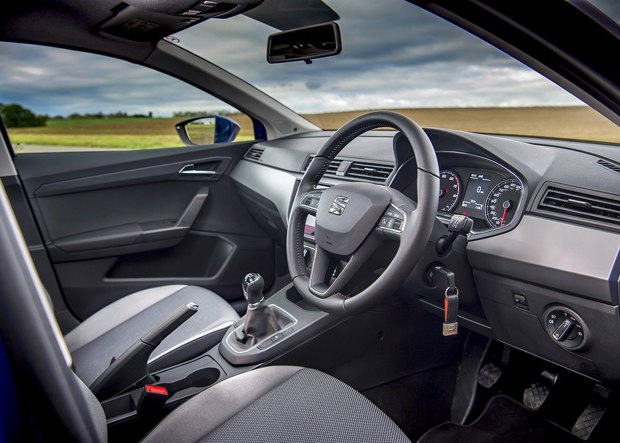
Date: 19 January 2018 | Current mileage: 5781 | Claimed economy: 60.1mpg | Actual economy: 54.3mpg
I have to admit that I get a sense of being short-changed each time I climb into the Ibiza. The minimalist interior, while neat, does have a feeling of sparseness that you don't get in Fiesta. The 50 shades of grey interior colour pallet does little to help matters either. And on a wet January afternoon, it’s difficult to know where the sky ends and dashboard begins.
Yet, for what it lacks in visual plushness, the Ibiza makes up for in comfort. In fact, it's a great car for winding down after a long day in the office, with its comfy seats and quiet engine providing a welcome break from the bustle of the outside world.
The seats are one area where the Ibiza shines, with the wide base and generous padding providing excellent back support. I've already taken the Ibiza from Cambridge to the Lake District and last week I had to venture 200 miles to the West County, yet I arrived feeling fresh thanks to the Ibiza's excellent all-round refinement.
With winter biting hard, the roads are suffering badly with ruts and potholes, but the Ibiza’s supple suspension and 15-inch wheels with 185/65 R15 tyres seem to take it all in their stride. Indeed, the ride quality is excellent. And even the deepest of potholes will leave little more than a suppressed thump in the ride.
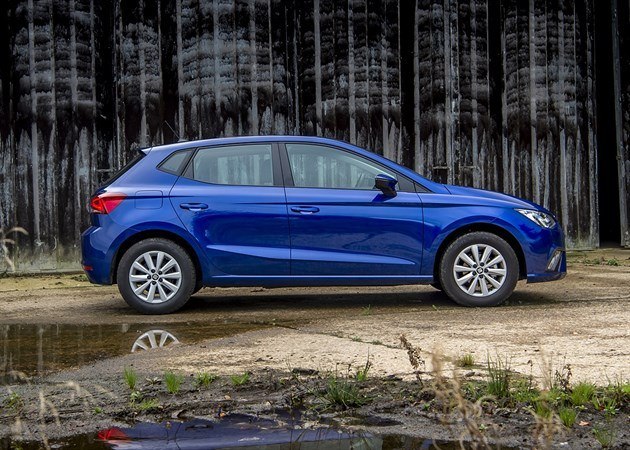
The Ibiza's large interior make it surprisingly practical and comfortable for long trips
The huge boot and five-door body style also give the Ibiza valuable Brownie points when it comes to everyday usability. The extra set of doors, for example, prevent passengers from leaving muddy footprints on the back of the seats, while the fold flat rear bench makes it easy to carry bulky items. In fact, as a small car package, I'd go as far to say that the Ibiza is one of the most-practical I've ever had.
A lot of the Ibiza's feel-good factor comes from its honest fuel economy. Over the past five months the 1.0 TSI engine has averaged in the mid-50s and this means it's a cheap car to use on my 62 mile daily commute, with the journey costing just £6.33 - based on 121.9p-per-litre of petrol.
The optional touchscreen navigation system has also saved my bacon on the daily commute, with live traffic updates providing useful reroutes to avoid delays and jams. On the downside, a twisty B road will highlight the Ibiza's shortcomings in the handling department. And while the drive is safe and predictable, the overpowered steering does feel like it's constantly fed through cotton wool.
The steering does come into its own in town. In fact, in my home town of Cambridge, the Ibiza is a sinch to swing into a space or hop across a busy junction. What's more, because the engine is quiet and cabin well made, you don't get much in the way of exterior noise in the cabin. Which again makes the Ibiza a great car for winding down in.
SEAT Ibiza end of term report
After six months and 6000+ miles, the time has come for Dan to say goodbye to his SEAT Ibiza, but will he be sorry to see it go?
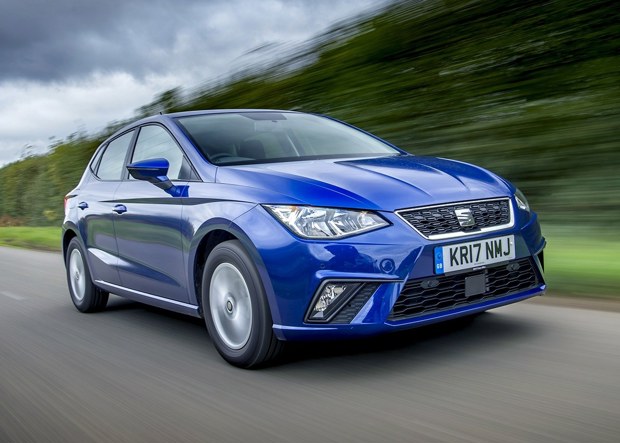
Date: 2 February 2018 | Current mileage: 6337 | Claimed economy: 60.1mpg | Actual economy: 54.4mpg
Another six months and another long termer is heading home after a long term stint with HonestJohn.co.uk. In the case of the SEAT Ibiza, it's been a mostly positive experience, with low fuel costs and lots of comfortable miles. Some 6337 to be exact.
So, what's good about the Ibiza? Well, it's cheap to run, practical and large enough for four large adults to fit without complaint. The 355-litre boot is also one of the largest load spaces of any compact hatchback on sale right now, which means the Ibiza will carry more shopping, more suitcases and more hockey kit than a Ford Focus.
Another feather in the Ibiza’s glittery headgear is its three-cylinder 1.0 TSI petrol engine. In short, it’s brilliant. In fact, I’d say this little petrol engine – which is also available in the Polo and Fabia, along with the Up – is the best three-cylinder engine on sale right now. No really, it's fantastic.
Smooth, quiet and efficient, I’ve really grown to love this little engine. It’s extremely refined for a little powerplant, which means you don’t get those toe-curling thrum noises as you accelerate hard to join a fast flowing motorway or pass slow moving traffic. It’s hushed at motorway speeds too, which means you don’t need a set of ear defenders to travel up or down the motorway.

Despite its rubbish ventilation system, the SEAT Ibiza has impressed Dan with its low fuel costs
It hasn’t all been plain sailing: the Ibiza’s temperamental air con has been a pain in the proverbial. Despite being sent to SEAT for a mechanical inspection, the Ibiza's ventilation system has never worked properly. Cold in the winter and hot in the summer, I've had the worst of both worlds and I've never experienced something so poor in a modern car.
However, while the ventilation system isn't very good, it doesn't totally diminish the fact that the Ibiza is a good all-rounder. The large interior and comfortable seats make it perfectly apt for long drives up and down the country and its affordable fuel costs make it extremely easy on the pocket. Indeed, over six months and 6000+ miles, it's seldom dropped a beat below 50mpg.
The Ibiza isn't as generously equipped as a Fiesta, but it trumps the Ford on space and practicality. Its three-cylinder engine is also head and shoulders above the EcoBoost petrol when it comes to performance and real world fuel economy. Yet, for all of its brilliance, I wouldn't buy a SEAT Ibiza.
Given the choice, I'd splash more cash and buy a Volkswagen Polo. Yes, I know it's more money to buy new - or fund via PCP - but in my view it's just a much better car. That's not to say the SEAT Ibiza is a bad car. And with a fully operation air con system I'd certainty consider it. Just not enough to walk past my local Volkswagen dealership.
